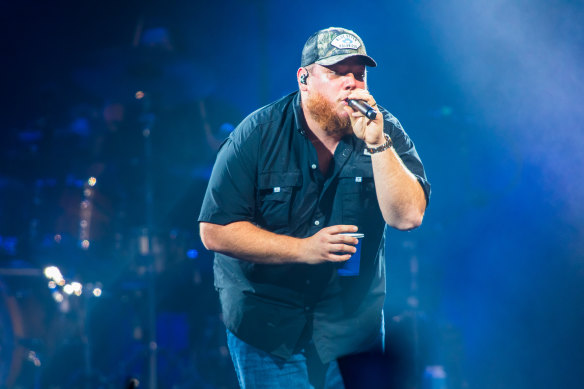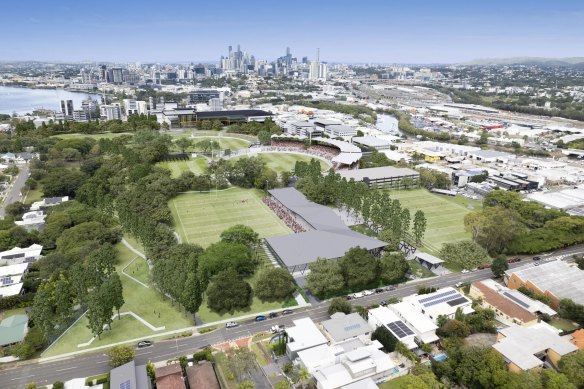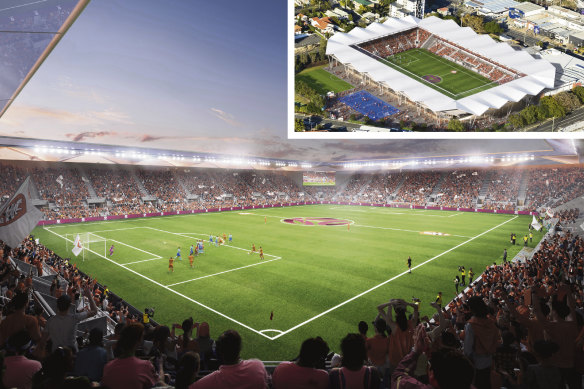- Perspective
- National
- Queensland
- Brisbane 2032 Olympics
This was published 6 months ago
An American country music star exposes Brisbane’s stadium gap
The latest round in the Brisbane Olympic stadium stoush shows just how far we’ve strayed from the original vision for the Games’ legacy on the city.
Last week, Brisbane 2032 president Andrew Liveris urged cricket and AFL – two sports, it’s fair to say, that are somewhat lacking in Olympic tradition – to “stand up” and argue for a venue worthy of the region’s growing population.
With the Gabba nearing the end of its life, there’s no doubting the need for a new or refurbished oval stadium in Brisbane. However, the architects of the Brisbane Olympic bid had something else in mind – and an American country music star has just demonstrated how on the money they were.

Luke Combs has forced the Brisbane Roar out of Suncorp Stadium.Credit: Rick Clifford
Suncorp Stadium, it was announced with great fanfare last week, will host two Luke Combs concerts on January 24 and 25 next year. As it happened, the Brisbane Roar was meant to play Adelaide United on the 25th.
Not surprisingly, the government-owned stadium did the maths and quickly realised a huge-drawing concert would bring in a lot more money than an A-League fixture, which would leave Suncorp mostly empty, even if the crowd did crack five figures.
So the Roar will now play Adelaide on April 22 on a Tuesday night – hardly conducive to attracting a decent crowd. If only there was a suitable alternative venue in Brisbane, Roar fans would still have their pre-public holiday night out.
Had the original plan for the 2032 Olympics been followed, any such (far-)future issues would have been avoided.
Given how the state government has taken the lead in organising (or not) the 2032 Games, it’s easy to forget the Council of Mayors (SEQ) – CoMSEQ for short, perhaps to the chagrin of a particular big bank – were the driving force of the Olympic bid.
Central to their vision was the catalytic nature of the Games, a way to fast-track transport improvements that were already needed in one of Australia’s fastest-growing regions.
But there was also sporting infrastructure, as outlined in the 2032 SEQ Olympic and Paralympic Games Feasibility Study produced by CoMSEQ in February, 2019 – namely, a new mid-sized rectangular stadium for Brisbane.

Queensland Cricket’s 2023 proposal for a 10,000-seat stadium at Albion was touted as part of the area’s Olympic precinct.Credit: Queensland Cricket
The original vision was for a new athletics stadium to be built – Albion Park was the suggested location – to be retrofitted, much like a Commonwealth Games stadium became Manchester City’s new home ground.
“Brisbane is … looking at the potential facility gaps and developing plans for new major venues, including to serve as engines to activate priority precincts and support broader urban development objectives,” CoMSEQ says in the feasibility study.
“The proposed master plan framework recognises these initiatives and proposes major stadia developments, as advised by key stakeholders.
“These focus on a new downtown arena project and a new ‘boutique’ stadium, which could be temporarily expanded for an Olympic and Paralympic Games.”

The state government has rejected a petition calling for a mid-size stadium, such as this Football Queensland vision, at Perry Park in Bowen Hills.Credit: Populous
A couple of months back, the state government rejected a petition with 2285 signatories calling for a mid-size stadium at Perry Park in Bowen Hills.
In doing so, Sports Minister Michael Healy cited the 2018 Stadiums Taskforce report, which found Brisbane had “current capacity for additional content within the existing venues”.
A lot has changed since its release.
There has been a doubling of the number of concerts allowed at Suncorp Stadium, for one, cramming even more into an already congested events calendar.
There has also been the meteoric rise of women’s sport and a second NRL team, with the possibility of another down the track. That will further add to the traffic at Suncorp.
“Prior to the Stadiums Taskforce review, there was an identified need for a 25,000 to 30,000-capacity stadium to supplement Suncorp Stadium at some stage in the period from 2028-2047,” CoMSEQ notes in its feasibility report.
“[A] new stadium has been included in the indicative master plan, allowing for temporary adaptation to increase the seating capacity to 55,000 at Games time.”
Ultimately though, it makes sense for Brisbane’s Olympic stadium, wherever it ends up, to be the future home of cricket and AFL.
But that won’t address the need for a “tier 2” rectangular stadium – and no, Ballymore just won’t cut it. As fantastic as it is, its public transport challenges mean it will remain a high-performance centre and community sports venue.
It could be Perry Park. It could be part of a new Victoria Park sports precinct. Or, if a new oval stadium does get built elsewhere, it could even be built on the Gabba’s footprint.
The Miles government has seemingly settled on its Games infrastructure. Should the political winds blow the LNP’s way next month, one hopes the need for a second-tier rectangular stadium in Brisbane forms part of the Crisafulli government’s mooted 100-day venues review.
Start the day with a summary of the most important and interesting stories, analysis and insights. Sign up for our Morning Edition newsletter.